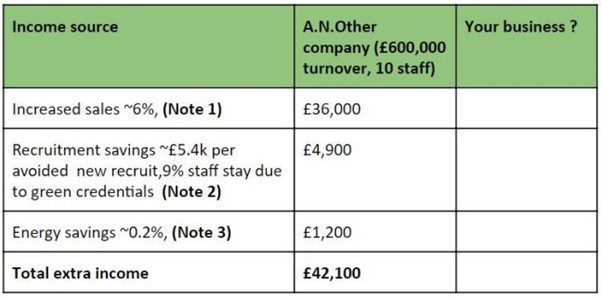
Establishing “green credentials” for an organisation can involve a little burden. But is it worth it? Of course, the real worth is a protected environment where we and our loved ones can all live, breathe and thrive happily. However, happiness is not enough of a business case at the moment, so this blog is about how to estimate the extra income from establishing and maintaining environmental credentials. This simple profits calculator was devised back in 2018 by our MD for “for profit” businesses. It could do with a bit of updating, but the rough orders of magnitude are about right. Here it is again.
You can use the table below to estimate this for your own business, using your own figures. It’s based on increased sales, reduced staffing costs and finally energy savings. The background and references are below. Health warning! There is no authoritative, single methodology for estimating extra income, so the data below is collected from a variety of sources and case studies. Savings will also vary wildly depending on type of industry.
Bear in mind, though, that there is money to be had. The Government’s Green Growth Strategy (BEIS 2017) cites an 11% p.a. expected growth rate for low carbon sector, £2.5 billion UK Government Investment in low carbon businesses and $13.5 trillion global private and public finance to be directed to clean energy sector.

I hope you find this useful. If you want to realise these income gains with green credentials, please get in touch. The extra income dwarfs the fees of establishing and maintaining green credentials. See also our related blog for the opportunities that climate change presents.
Note 1 – increased sales
Around 6% average increase in sales can be attributed to adopting an environmental approach. This is estimated from various sources:
Unilever – sustainable living products 2% more profitable, 50% of growth comes from sustainable living products.
Ikea – 29% increase in sales contribute to more sustainable living. https://www.environmentalleader.com/2016/01/how-unilever-ge-ikea-turn-a-profit-from-sustainability/
13% of businesses do sustainability because they think it will improve sales/market share.
13% increase in sales for Whole Foods Market. https://www.mckinsey.com/business-functions/sustainability-and-resource-productivity/our-insights/the-business-of-sustainability-mckinsey-global-survey-results
10-13% extra people willing to pay more for green products http://www.nielsen.com/uk/en/insights/news/2015/green-generation-millennials-say-sustainability-is-a-shopping-priority.html
5-10% growth in sales for a range of ethical products http://www.retailresearch.org/retailethics.php
Note 2 – reduced recruitment costs
There is growing recognition that millennials and Gen Z employees want to work for businesses that have “purpose”. Good environmental credentials help demonstrate that purpose. £5,400 has been used for the cost of a new recruit. Average staff turnover in UK is 15%, 59% are millennials/Gen Z. So the calculation assumes that 9% of staff leaving (59% of 15%) is due to lack of green credentials. Hopefully, establishing credentials will help reduce turnover.
Unilever state that 50% of graduates cite green credentials as a reason for joining their company. https://www.environmentalleader.com/2016/01/how-unilever-ge-ikea-turn-a-profit-from-sustainability/
11% of businesses do sustainability to improve employee motivation and/or retention. https://www.mckinsey.com/business-functions/sustainability-and-resource-productivity/our-insights/the-business-of-sustainability-mckinsey-global-survey-results
70% of millennials expect employer to do societal improvement work https://www.triplepundit.com/2015/08/sustainability-strategy-can-pivotal-employee-engagement/
Recruitment costs are £5,400 logistics alone (but estimated to be up to £30,000 due to lost productivity of new employee) http://www.hrreview.co.uk/hr-news/recruitment/it-costs-over-30k-to-replace-a-staff-member/50677
59% 0f workforce is millennials and Gen Z: http://www.parkcom.co.uk/millennials-rule-workforce-2020/
15% staff turnover http://www.hrmagazine.co.uk/article-details/turnover-rate-reaches-new-high
Note 3 – energy savings
These are typically (and unfortunately) the smallest source of income. Nevertheless there are lots of potential savings to be made for relatively low investment. For this estimate 0.2% of turnover is used. This is based on 20% typical energy savings and 1% of business costs are spent on energy.
20% typical energy cost reduction – “Eddie explains ESOS phase 2” booklet
1% of business costs are energy – “Health, Wellbeing and Productivity in Offices”, World Green Building Council
